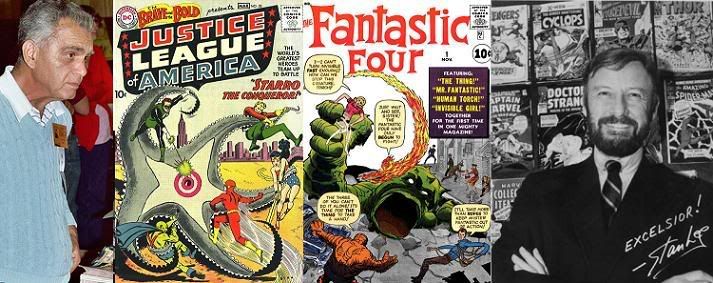
Chapter 6 of Will Jacobs and Gerard Jones' 1985 The Comic Book Heroes, titled "The Fantastic Four," was heavily rewritten by Jones to become Chapter 7 of his 1997 revision, "With The Sudden Fury of a Thunderbolt." Jones placed heavy emphasis on the apocryphal nature of the infamous tale of a golf game between Jack Liebowitz and Martin Goodman. Supposedly the former bragged about the sales figures of the Justice League of America to the latter, who immediately demanded his cousin/nephew-in-law Stanley Lieber create a knock-off. Hence, the Fantastic Four was born, or so the story goes. The truth of the matter is less certain, as skin mag publisher Goodman was a slightly shady character. He burned through at least fifty corporate identities, often with several running simultaneously, to avoid any one's going under bringing down the whole "empire." As for Stanley Lieber, well, it's not like ol' Stan "The Man" Lee doesn't have a reputation for embellishing or misremembering the truth. "Others involved with the company have said that Goodman had a paid informant within Independent News," which distributed DC Comics, as well as his own.
Stan Lee had spent his entire professional life working under Goodman, and had been heavily influenced by the comic writers who had preceeded him at whatever his company was called on any given month. Of features like Namor the Sub-Mariner, the Human Torch and Captain America, the 1985 edition noted, "The elements embodied in these characters-- the antihero at odds with society, the extra-powerful being who is frail at heart, heroes who fight one another, and the hero as social or political symbol-- were to remain in Lee's mind through the 1960s." Jones continued in the '97 edition, explaining that Jack Kirby had first left Goodman's company over a royalty dispute, but was now cornered by strained relations with DC and the indifference of Archie back into returning to Goodman's fold. Lee also directed scripting jobs to his brother, Larry Lieber, and had fed newcomer Steve Ditko enough work to keep him from contributing much at Charlton. They combined to form the creative backbone of what would become Marvel Comics.
Kirby claimed he created the Fantastic Four all by himself, adapting his model from the Challengers of the Unknown to suit his new home. Lee claimed his authorship was inspired by a lecture from his wife to focus his attention on his comics work over random freelancing in magazines. Having spent all of his life inside comics, instead of doing time in the pulps like Schwartz, Weisinger & co., left Lee with no prose outlet for his more mature writing impulses. He instead directed them at his new project, the aforementioned Justice League swipe, and handed a two-page plot summary to Kirby. "What we can venture to say, after comparing their work together to their work with others, is that Kirby clearly appears to have done most of the plotting, and probably created most of the principle characters, but that Lee supplied all the dialogue and most of the character nuance. And that's probably enough to know, because it was their two talents together that made the Lee-Kirby, or Kirby-Lee, superheroes the most potent since superheroes were born."
You can buy the 1997 edition of The Comic Book Heroes: The First History of Modern Comic Books - From the Silver Age to the Present from Amazon.com.


No comments:
Post a Comment